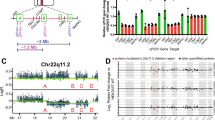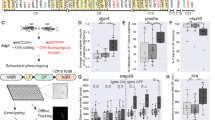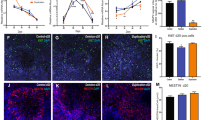Abstract
Somatic inactivation of PTEN occurs in different human tumors including glioblastoma, endometrial carcinoma and prostate carcinoma. Germline mutations in PTEN result in a range of phenotypic abnormalities that occur with variable penetrance, including neurological features such as macrocephaly, seizures, ataxia and Lhermitte-Duclos disease (also described as dysplastic gangliocytoma of the cerebellum). Homozygous deletion of Pten causes embryonic lethality in mice. To investigate function in the brain, we used Cre-loxP technology to selectively inactivate Pten in specific mouse neuronal populations. Loss of Pten resulted in progressive macrocephaly and seizures. Neurons lacking Pten expressed high levels of phosphorylated Akt and showed a progressive increase in soma size without evidence of abnormal proliferation. Cerebellar abnormalities closely resembled the histopathology of human Lhermitte-Duclos disease. These results indicate that Pten regulates neuronal size in vivo in a cell-autonomous manner and provide new insights into the etiology of Lhermitte-Duclos disease.
This is a preview of subscription content, access via your institution
Access options
Subscribe to this journal
Receive 12 print issues and online access
We are sorry, but there is no personal subscription option available for your country.
Buy this article
- Purchase on SpringerLink
- Instant access to full article PDF
Prices may be subject to local taxes which are calculated during checkout







Similar content being viewed by others
References
Maehama, T. & Dixon, J.E. The tumor suppressor, PTEN/MMAC1, dephosphorylates the lipid second messenger, phosphatidylinositol 3,4,5-trisphosphate. J. Biol. Chem. 273, 13375–13378 (1998).
Leevers, S.J., Vanhaesebroeck, B. & Waterfield, M.D. Signalling through phosphoinositide 3-kinases: the lipids take centre stage. Curr. Opin. Cell Biol. 11, 219–225 (1999).
Li, J. et al. PTEN, a putative protein tyrosine phosphatase gene mutated in human brain, breast, and prostate cancer. Science 275, 1943–1947 (1997).
Steck, P.A. et al. Identification of a candidate tumour suppressor gene, MMAC1, at chromosome 10q23.3 that is mutated in multiple advanced cancers. Nature Genet. 15, 356–362 (1997).
Bonneau, D. & Longy, M. Mutations of the human PTEN gene. Hum. Mutat. 16, 109–122 (2000).
Dahia, P.L. et al. PTEN is inversely correlated with the cell survival factor Akt/PKB and is inactivated via multiple mechanisms in haematological malignancies. Hum. Mol. Genet. 8, 185–193 (1999).
Wu, X., Senechal, K., Neshat, M.S., Whang, Y.E. & Sawyers, C.L. The PTEN/MMAC1 tumor suppressor phosphatase functions as a negative regulator of the phosphoinositide 3-kinase/Akt pathway. Proc. Natl Acad. Sci. USA 95, 15587–15591 (1998).
Marsh, D.J. et al. PTEN mutation spectrum and genotype-phenotype correlations in Bannayan-Riley-Ruvalcaba syndrome suggest a single entity with Cowden syndrome. Hum. Mol. Genet. 8, 1461–1472 (1999).
Di Cristofano, A., Pesce, B., Cordon-Cardo, C. & Pandolfi, P.P. Pten is essential for embryonic development and tumour suppression. Nature Genet. 19, 348–355 (1998).
Suzuki, A. et al. High cancer susceptibility and embryonic lethality associated with mutation of the PTEN tumor suppressor gene in mice. Curr. Biol. 8, 1169–1178 (1998).
Podsypanina, K. et al. Mutation of Pten/Mmac1 in mice causes neoplasia in multiple organ systems. Proc. Natl Acad. Sci. USA 96, 1563–1568 (1999).
Stambolic, V. et al. High incidence of breast and endometrial neoplasia resembling human Cowden syndrome in Pten+/− mice. Cancer Res. 60, 3605–3611 (2000).
Di Cristofano, A. et al. Impaired Fas response and autoimmunity in Pten+/− mice. Science 285, 2122–2125 (1999).
Suzuki, A. et al. T cell-specific loss of Pten leads to defects in central and peripheral tolerance. Immunity 14, 523–534 (2001).
Di Cristofano, A., De Acetis, M., Koff, A., Cordon-Cardo, C. & Pandolfi, P.P. Pten and p27KIP1 cooperate in prostate cancer tumor suppression in the mouse. Nature Genet. 27, 222–224 (2001).
Li, Y. et al. Deficiency of Pten accelerates mammary oncogenesis in MMTV-Wnt-1 transgenic mice. BMC Mol. Biol. 2, 2 (2001).
Toggas, S.M. et al. Central nervous system damage produced by expression of the HIV-1 coat protein gp120 in transgenic mice. Nature 367, 188–193 (1994).
Soriano, P. Generalized lacZ expression with the ROSA26 Cre reporter strain. Nature Genet. 21, 70–71 (1999).
Marino, S., Vooijs, M., van Der Gulden, H., Jonkers, J. & Berns, A. Induction of medulloblastomas in p53-null mutant mice by somatic inactivation of Rb in the external granular layer cells of the cerebellum. Genes Dev. 14, 994–1004 (2000).
Goldowitz, D., Hamre, K.M., Przyborski, S.A. & Ackerman, S.L. Granule cells and cerebellar boundaries: analysis of Unc5h3 mutant chimeras. J. Neurosci. 20, 4129–4137 (2000).
Zhu, Y. et al. Ablation of NF1 function in neurons induces abnormal development of cerebral cortex and reactive gliosis in the brain. Genes Dev. 15, 859–876 (2001).
Mucke, L., Oldstone, M.B., Morris, J.C. & Nerenberg, M.I. Rapid activation of astrocyte-specific expression of GFAP-lacZ transgene by focal injury. New Biol. 3, 465–474 (1991).
Kuhar, S.G. et al. Changing patterns of gene expression define four stages of cerebellar granule neuron differentiation. Development 117, 97–104 (1993).
Cantley, L.C. & Neel, B.G. New insights into tumor suppression: PTEN suppresses tumor formation by restraining the phosphoinositide 3-kinase/AKT pathway. Proc. Natl Acad. Sci.USA 96, 4240–4245 (1999).
Bruni, P. et al. PTEN expression is reduced in a subset of sporadic thyroid carcinomas: evidence that PTEN-growth suppressing activity in thyroid cancer cells mediated by p27kip1. Oncogene 19, 3146–3155 (2000).
Sun, H. et al. PTEN modulates cell cycle progression and cell survival by regulating phosphatidylinositol 3,4,5,-trisphosphate and Akt/protein kinase B signaling pathway. Proc. Natl Acad. Sci. USA 96, 6199–6204 (1999).
Nakamura, N. et al. Forkhead transcription factors are critical effectors of cell death and cell cycle arrest downstream of PTEN. Mol. Cell. Biol. 20, 8969–8982 (2000).
Mamillapalli, R. et al. PTEN regulates the ubiquitin-dependent degradation of the CDK inhibitor p27(KIP1) through the ubiquitin E3 ligase SCF(SKP2). Curr. Biol. 11, 263–267 (2001).
Rainov, N.G., Holzhausen, H.J. & Burkert, W. Dysplastic gangliocytoma of the cerebellum (Lhermitte-Duclos disease). Clin. Neurol. Neurosurg. 97, 175–180 (1995).
Tuli, S., Provias, J.P. & Bernstein, M. Lhermitte-Duclos disease: literature review and novel treatment strategy. Can. J. Neurol. Sci. 24, 155–160 (1997).
Marcus, C.D. et al. Lhermitte-Duclos disease associated with syringomyelia. Neuroradiology 38, 529–531 (1996).
Robinson, S. & Cohen, A.R. Cowden disease and Lhermitte-Duclos disease: characterization of a new phakomatosis. Neurosurgery 46, 371–383 (2000).
Iida, S. et al. A heterozygous frameshift mutation of the PTEN/MMAC1 gene in a patient with Lhermitte-Duclos disease—only the mutated allele was expressed in the cerebellar tumor. Int. J. Mol. Med. 1, 925–929 (1998).
Vinchon, M. et al. Association of Lhermitte-Duclos and Cowden disease: report of a new case and review of the literature. J. Neurol. Neurosurg. Psychiatry 57, 699–704 (1994).
Li, J. et al. The PTEN/MMAC1 tumor suppressor induces cell death that is rescued by the AKT/protein kinase B oncogene. Cancer Res. 58, 5667–5672 (1998).
Davies, M.A. et al. Adenoviral transgene expression of MMAC/PTEN in human glioma cells inhibits Akt activation and induces anoikis. Cancer Res. 58, 5285–5290 (1998).
Furnari, F.B., Huang, H.J. & Cavenee, W.K. The phosphoinositol phosphatase activity of PTEN mediates a serum-sensitive G1 growth arrest in glioma cells. Cancer Res. 58, 5002–5008 (1998).
Cheney, I.W., Neuteboom, S.T., Vaillancourt, M.T., Ramachandra, M. & Bookstein, R. Adenovirus-mediated gene transfer of MMAC1/PTEN to glioblastoma cells inhibits S phase entry by the recruitment of p27Kip1 into cyclin E/CDK2 complexes. Cancer Res. 59, 2318–2323 (1999).
Li, D.M. & Sun, H. PTEN/MMAC1/TEP1 suppresses the tumorigenicity and induces G1 cell cycle arrest in human glioblastoma cells. Proc. Natl Acad. Sci. USA 95, 15406–15411 (1998).
Zhu, X., Kwon, C.H., Schlosshauer, P.W., Ellenson, L.H. & Baker, S.J. PTEN induces G(1) cell cycle arrest and decreases cyclin D3 levels in endometrial carcinoma cells. Cancer Res. 61, 4569–4575 (2001).
Datta, S.R., Brunet, A. & Greenberg, M.E. Cellular survival: a play in three Akts. Genes Dev. 13, 2905–2927 (1999).
Dudek, H. et al. Regulation of neuronal survival by the serine-threonine protein kinase Akt. Science 275, 661–665 (1997).
Gao, X., Neufeld, T.P. & Pan, D. Drosophila PTEN regulates cell growth and proliferation through PI3K-dependent and -independent pathways. Dev. Biol. 221, 404–418 (2000).
Goberdhan, D.C., Paricio, N., Goodman, E.C., Mlodzik, M. & Wilson, C. Drosophila tumor suppressor PTEN controls cell size and number by antagonizing the Chico/PI3-kinase signaling pathway. Genes Dev. 13, 3244–3258 (1999).
Huang, H. et al. PTEN affects cell size, cell proliferation and apoptosis during Drosophila eye development. Development 126, 5365–5372 (1999).
Stocker, H. & Hafen, E. Genetic control of cell size. Curr. Opin. Genet. Dev. 10, 529–535 (2000).
Shioi, T. et al. The conserved phosphoinositide 3-kinase pathway determines heart size in mice. EMBO J. 19, 2537–2548 (2000).
Tuttle, R.L. et al. Regulation of pancreatic β-cell growth and survival by the serine/threonine protein kinase Akt1/PKBα. Nature Med. 7, 1133–1137 (2001).
Gu, H., Zou, Y.R. & Rajewsky, K. Independent control of immunoglobulin switch recombination at individual switch regions evidenced through Cre-loxP-mediated gene _targeting. Cell 73, 1155–1164 (1993).
Miyazawa, K. et al. A role for p27/Kip1 in the control of cerebellar granule cell precursor proliferation. J. Neurosci. 20, 5756–5763 (2000).
Acknowledgements
The authors thank T. Curran, P. McKinnon, M. Yuzaki, L.H. Ellenson and C. Wetmore for helpful discussions, L. Li for transgenic microinjections, Y. Lee, D. Rice, J. Wigle, S. Magdaleno, J. Cunningham and S. Lloyd for technical advice, G. Murti and K. Barnes for confocal microscopy and T. Mak and S. Backman for discussing results prior to publication. This work was supported in part by a National Institutes of Health (NIH) Cancer Center Support CORE grant, NIH grants CA21765 and CA71907 (S.J.B.) and the American Lebanese Syrian Associated Charities (ALSAC).
Author information
Authors and Affiliations
Corresponding author
Supplementary information
Rights and permissions
About this article
Cite this article
Kwon, CH., Zhu, X., Zhang, J. et al. Pten regulates neuronal soma size: a mouse model of Lhermitte-Duclos disease. Nat Genet 29, 404–411 (2001). https://doi.org/10.1038/ng781
Received:
Accepted:
Published:
Issue Date:
DOI: https://doi.org/10.1038/ng781
This article is cited by
-
Cross-level analysis of molecular and neurobehavioral function in a prospective series of patients with germline heterozygous PTEN mutations with and without autism
Molecular Autism (2021)
-
Modelling genetic mosaicism of neurodevelopmental disorders in vivo by a Cre-amplifying fluorescent reporter
Nature Communications (2020)
-
Full function of exon junction complex factor, Rbm8a, is critical for interneuron development
Translational Psychiatry (2020)
-
Neuromorphometric changes associated with photostimulated migratory phenotype in the Palaearctic–Indian male redheaded bunting
Experimental Brain Research (2020)
-
Pten loss results in inappropriate excitatory connectivity
Molecular Psychiatry (2019)



